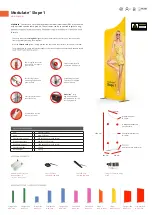
5.1 The differential unison
engine (DUNE)
Traditionally, unison on synthesizers means "playing
all voices simultaneously". In unison mode, a classic
synthesizer with 8 voices simply fires all 8 voices simul-
taneously when pressing a key. The different voices
are slightly detuned, which provides a chorus type ef-
fect and thus an overall fat sound, when playing a
note. Unfortunately, firing all voices at once means
that polyphonic play is no longer possible, as all avail-
able voices are in use. Hence, modern synthesizers use
a more sophisticated unison mode, which allows to set
an arbitrary number of unison voices that is only a
subset of the total number of available voices. For ex-
ample, a synthesizer with a maximum of 32 voices may
offer the option to trigger 4 unison voices simultane-
ously. This still allows to play 8 notes at the same
time (32 / 4 = 8). Another feature that is very com-
mon in today’s synthesizers is the ability to specify an
arbitrary detuning and stereo spreading of all unison
voices. A synthesizer which employs 2 unison voices
may detune both and spread them to the left and right
side of the stereo panorama, which creates a very spa-
cious effect. The Synapse Audio WASP is such a syn-
thesizer.
The idea behind Dune is to make the power of the
unison mode accessible to sound designers. Why re-
strict the unison mode to just detuning or panorama
changes?
In Dune, any sound parameter can be
changed in any unison voice, relative to the basic pa-
rameter settings. This is accomplished by the modu-
lation matrix. Apart from the classic source, amount
and destination parameters, Dune adds the "Voice"
parameter, which allows to restrict the modulation to
one or more unison voices. This concept is best ex-
plained by a simple example matrix:
In this example, we have assigned all three LFOs
to three different destinations:
Filter Cutoff, Pan
(Panorama) and Volume. In the first row, the Voice
field is left blank, which simply means to apply the
modulation to all unison voices in use. If the number
of unison voices is set to e.g. five voices, then the fil-
ter cutoff will be modulated in the same manner for
all five voices. The second and third column, set to
modulate the volume and panorama, are restricted to
affect the second and third unison voice, respectively.
As a result, only those voices will be modulated. To
experiment with and understand the unison engine, try
the example above (or something similar) on an empty
58
DUNE 2 User’s Manual
Summary of Contents for DUNE 2
Page 1: ...User s Manual...
















































